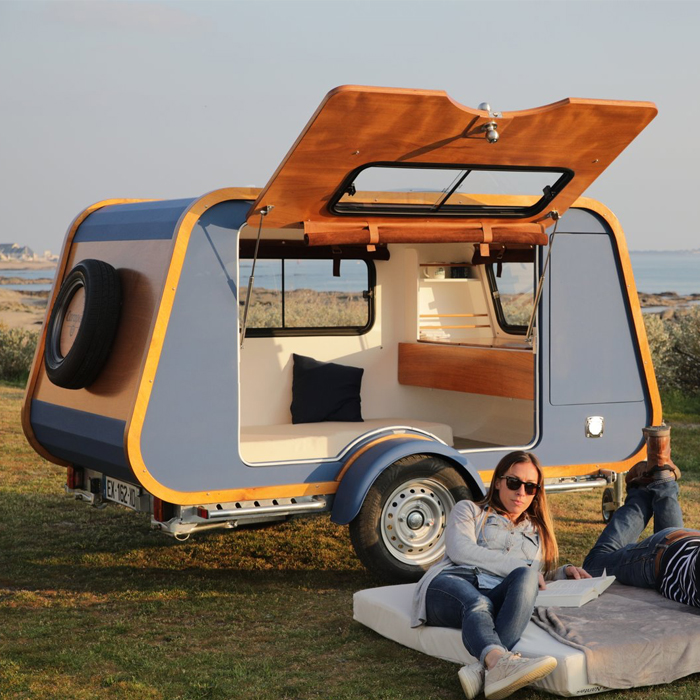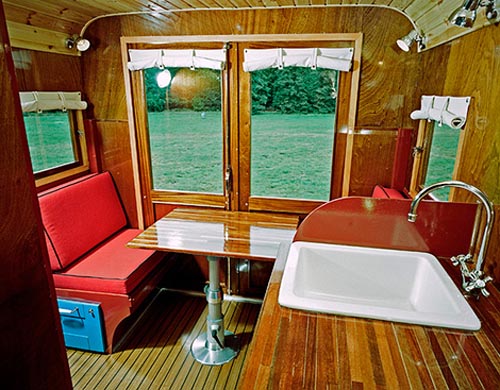TAXA Outdoors’ NASA-Inspired Campers
We speak with Garrett Finney about how designing for astronauts influences his more down-to-earth vehicles

Traditional campers, the types that sit dormant in driveways or clunk their way into commercial campsites, rarely excite design enthusiasts. Their interiors are outdated and the exteriors leave plenty to be desired. But for TAXA Outdoors, campers are meant to be an enhancement to your trip, providing a home-base in which you can have confidence. Their Cricket camper epitomizes this. At 15 feet long, it features a pop-up roof for ventilation and added space, and it accommodates two adults and two children. Further, it can be towed by most four-cylinder vehicles. It also draws on unexpected influences.
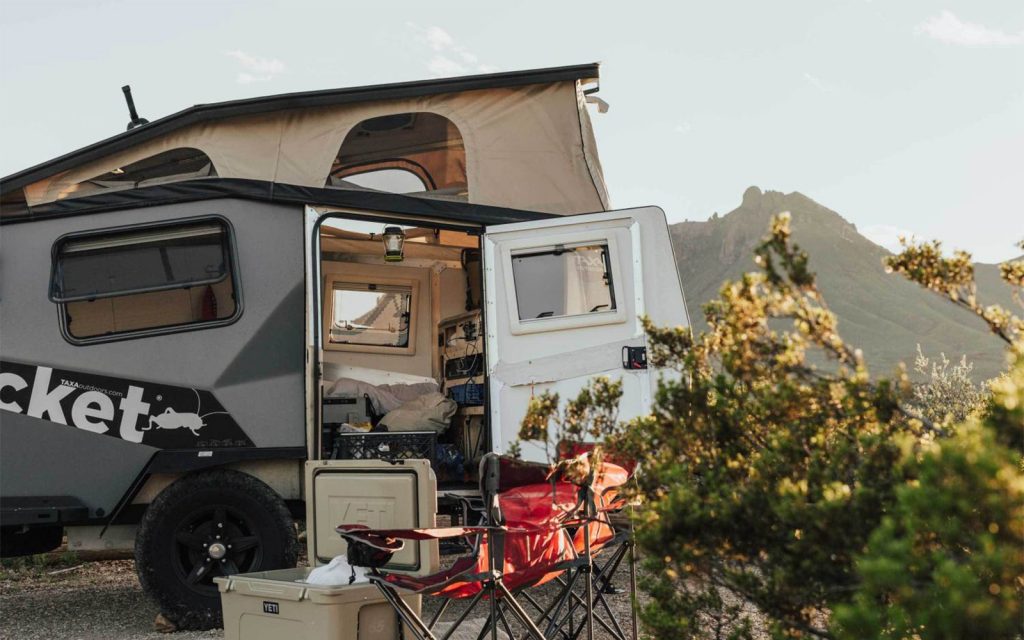
TAXA Outdoor founder, CEO and chief designer Garrett Finney isn’t a lifelong, tenured member of the RV industry. He’s an architect who won the Rome Prize (1994) and has formal undergraduate and graduate degrees from Yale. (He’s also a professor and lecturer.) He also designed for NASA—specifically interiors for astronauts.

During the ’90s, at fairs like TIFF, Finney stood out for his efficiently made furniture. His designs were focused, visionary and rooted in subverting the notion that excessiveness meant excellence. It was at this time that a friend was working at NASA. “It was a wonderful coincidence of timing,” he tells us. “I visited her work and met lots of people, and I had this reasonably sexy, efficient furniture that NASA people could say, ‘Oh? Efficient for spaceflight,’ in the back of their minds.”

During this time, Finney rejected 100% of his first furniture run from his producer, which he says, “was very sad, but at the same time the folks at NASA were coming up with a new office (the Habitability Design Center) that they felt NASA needed. It was right at the beginning, right when the first Russian module was being attached to the first two US modules of the International Space Station.”
Finney seemed to be an obvious choice to head the Habitability Design Center’s projects—in part because he wasn’t an engineer. “That’s the office that had been under consideration when I was visiting NASA,” he explains. “Engineers can be brilliant at X and Y, but we need some Z—and maybe some other stuff.”
His vision was clear and he approached it considering how astronauts would interact with their setting, and how their quality of life would impact their efficiency and workflow. “They knew that if you were going up for a six-month mission (as opposed to a two-week shuttle mission) that astronauts who’d gone up on the Russian space station would have 15 hours of productive time to do science and work. And, at the end of six months, they had [done only] six or eight hours. So where does that time go?” he explains, “Time, especially in the US at NASA, was all about justifying budgets to Congress—like, ‘Our astronauts will have all this time to do miraculous science and this and that.’ And yet, something about quality of life was diminishing the astronauts’ ability to have productive time.”
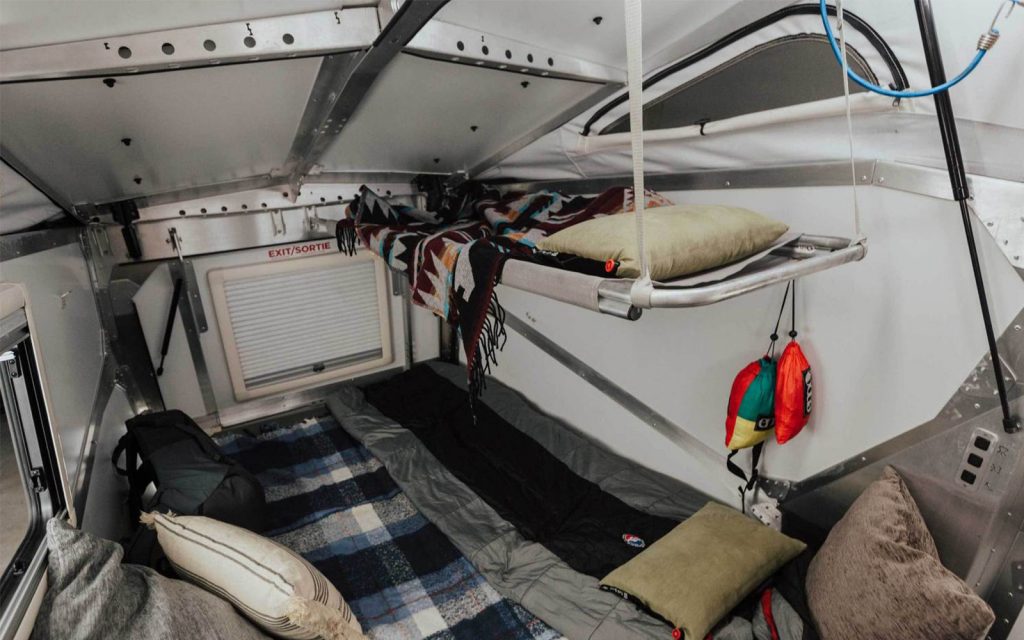
So Finney was brought on as one of the office’s leads, and his mission was to improve efficiency in space by thinking about the astronauts’ general well-being—obviously a complicated and multidimensional concept.
“It’s not beauty. It’s not like designing a sexy house. It’s really that we have to eliminate fear and depression and work on communication with spouses on Earth and integrating people,” he explains. “I worked on a lot of crew-related design problems, or manufacturing problems related to crew quarters, and cooking food and going to the bathroom and trying to run—trying to allow for a person in space, as opposed to just a human that could breathe and was assigned tasks.”
Beyond that, Finney needed to consider different genders, nationalities, languages, cultural norms and more, adding, “All of these people have different definitions of personal space and privacy and expectations about what ‘roughing it’ is.”

The constraints he was forced to work within (including pitching human-centric design to engineers and rocket scientists) forged his precise style. He was ultra-focused on how spaces impacted our livelihoods.
“At NASA, they know how much hair falls off your head and how many skin cells fall off your body because it ends up in an air filter and becomes a garbage problem. That is so true on Earth too except there are all these assumptions we don’t even have to make: that we can breathe, that we’re not really concerned about how many skin cells are falling and stuff like that.”

This highly methodic process carried over into Finney’s post-NASA work. After four years there, he moved on but was still living in Texas. “In Texas, I realized that everyone, but more literally one in 11 families, owns an RV.” This realization led to him founding TAXA Outdoors in 2009.
“Camping is important and [you should] leave your house at home,” he continues. “Why are you bringing a vacuum cleaner to a National Park? Why are people designing something with big flat screen TVs for people to take to parks? People ask, ‘Where’s the product for me? I have two small kids, I don’t want to sleep on the ground. There are tarantulas in Texas and snakes, but I want to go camping.’ There’s a big Venn diagram overlapping comfort, safety and security—I have a big earful of NASA training about how to talk about that—and how to design products that fit into that sort of ecosystem.”
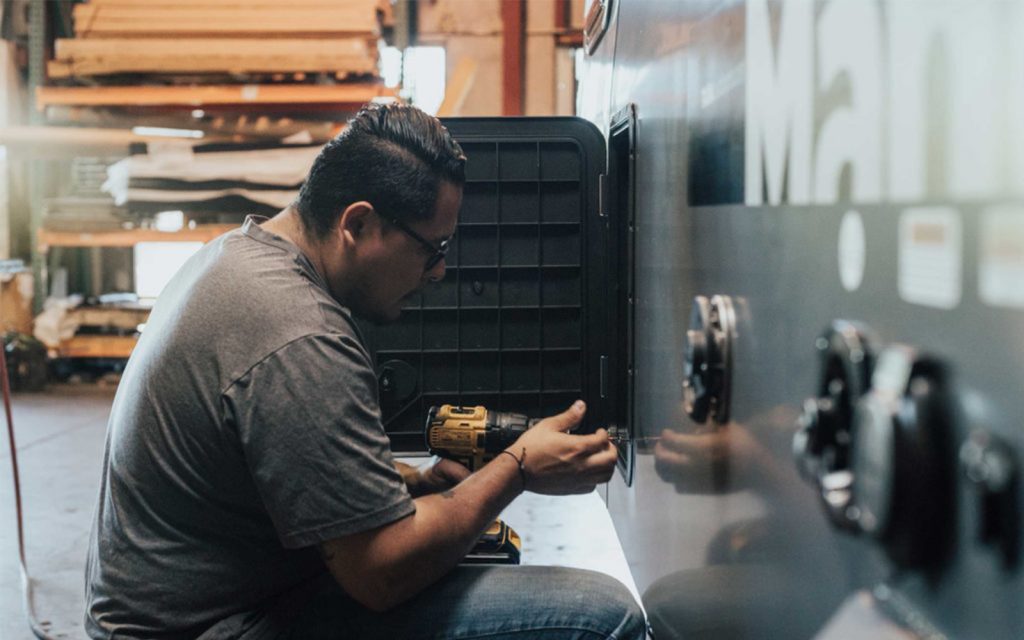
While applying formal architectural training and NASA tenure to campers may not seem like a fit, for Finney, the process is almost no different. People, and all their different preferences and needs, are still at the center. Plus Airstreams were, and still are in some capacity, the holding chamber for astronauts returning from the beyond.

TAXA Outdoors’ Cricket is smaller than most RVs. “It’s not that I want to force people outside, but we assume that our people want to be outside if they can,” Finney says. “But if they’re forced inside by the cold or a bear or a bug or the weather, we want it to be really nice and snug.”
While each Cricket is identical, after purchase, no two are the same. Finney says, “What if the people in the cricket are 75? What if they’re 25? What if they’re 45 and have an infant? It’s just so cool to see all the different people, but also how they all live in it. What have they attached to the ceiling? Did they change the kitchen? What do they use as cooking supplies? It looks really highly stylized in many ways, but it’s highly usable in different ways by a lot of different people.”
Images courtesy of TAXA Outdoors
